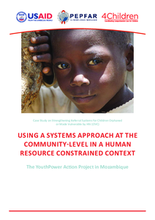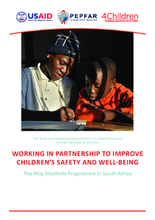Displaying 271 - 280 of 499
The article examines how 36 child welfare caseworkers in 6 different teams in Norway investigate, assess, and make decisions at the phase of an incoming referral.
This Manual includes background information, standard operating procedures with documentation tools and job aids on case management.
In this webinar from RISE Learning Network, the speaker, Yashoda Upreti shares how Terre des Hommes in Nepal has implemented a case management program.
This case study is one in a series of case studies highlighting different aspects of a case management system and referral mechanisms utilized by OVC programs. The case study presents a program in Mozambique that could be identified as a hub and spoke model of referral mechanism.
This case study is one in a series of case studies highlighting different aspects of a case management system and referral mechanisms utilized by OVC programs. The case study looks at the work of the Children in Distress Network (CINDI) in the uMgungundlovu District of KwaZulu-Natal Province (KZN) of South Africa.
This study examined communication between 51 transition-aged foster youth and their social workers as related to perceived relationship quality and satisfaction with care receipt/provision.
Through qualitative interviews with local child protection workers, this paper indicates that traditional values assist legislative intervention and that significant potential exists in better integration of Indigenous approaches into practice.
This quantitative study contributes knowledge regarding the attitude of professionals towards positive parenting and child participation.
This study examined the associations between exposure to armed conflict, perceived support, work experience, needing help, and post-traumatic distress among Israeli social workers in foster care agencies based on Conservation of Resources theory.
The objective of this evaluation is to document and assess how the capacity of the child protection system in Ghana—in particular the practices of the Social Welfare Actors (SWA)—has changed to enable the provision of quality services to children and families with support of the workforce strengthening (WFS) initiative.




